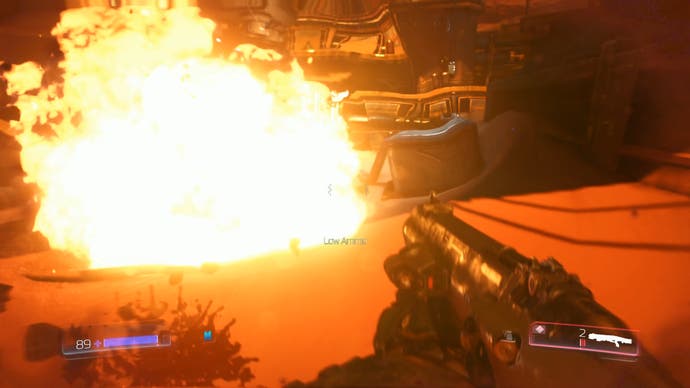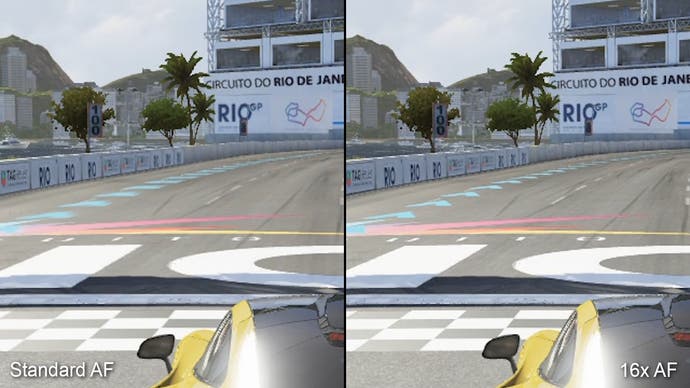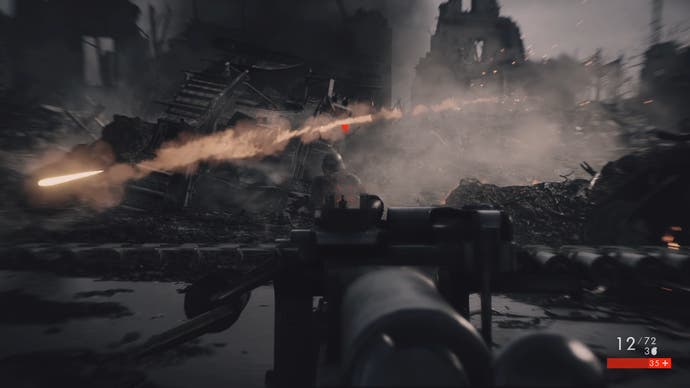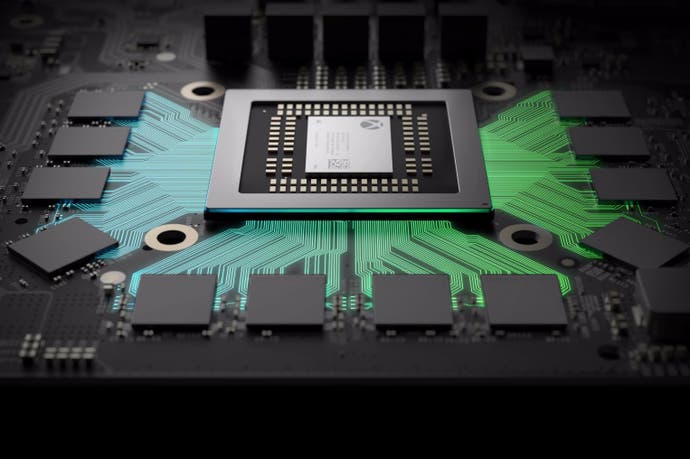Five ways your Xbox One and 360 games will be better on Scorpio
Smoother frame-rates, no tearing, faster loading - and more.
The next Xbox, codenamed Project Scorpio, features 100 per cent compatibility with any software that runs on the existing Xbox One console, be it the latest triple-A blockbuster or any one of the hundreds of Xbox 360 titles successfully adapted via Microsoft's backward compatibility programme.
Everything should run just fine, but more than that, the full power of the Scorpio Engine will be brought to bear on enhancing your existing games. According to the Xbox hardware team, your existing library of games should run smoother, look better and load faster.
It's a considerable technical achievement because, while the new console is built from the ground up to run all content, certain design decisions were made during the machine's gestation period that make this task a whole lot harder than it might have been. Put simply - there's an easier way, exemplified by PlayStation 4 Pro's technical make-up, and then there's the more challenging approach - the Scorpio way.
"In designing for compatibility, there are two choices that we can take from a performance perspective," Microsoft's Andrew Goossen, Technical Fellow, Graphics tells us. "One of which is to design hardware to emulate the performance capabilities of the original [console] as much as possible, or the other one is to say, we're just going to turn on all the performance and we're going to deal with all the issues."
What Goossen described as the 'emulation' approach is seen in PS4 Pro's design. Sony's latest console uses a 'butterfly' approach to GPU design, effectively mirroring the base unit's GPU with an extra rank of 18 compute units, doubling power (more so once extra frequency is added). With this approach, Sony can ensure complete compatibility simply by turning off the additional, new 'half' of the graphics core. It's an elegant solution, but what's clear is that the newly introduced boost mode doesn't deliver the Pro's full power to existing base PS4 titles.
Microsoft has taken the harder route - and it has done so by necessity. It doesn't have the option of doubling up on its existing design, as Scorpio is a radical architectural overhaul. Here, it's down to the platform holder to take ownership of compatibility issues, but the advantage is this: unlike PS4's boost mode, Scorpio theoretically allows for the full power of the new console to be deployed on older games. In fact, there are five different ways in which Scorpio aims to improve the experience for owners of existing Xbox One games - and these should also apply to Xbox 360 back-compat titles.
1. Smoother performance and no screen-tearing
"We bring to bear all 40 compute units and the full 1172MHz clock-speed [of the Scorpio GPU], we're bringing those to bear on all the games possible," says Andrew Goossen. "Now, I have a caveat a bit later about all the compatibility testing we do for these and some of the implications, but we can bring all the 40CUs, all 1172MHz, of course the full 2.3GHz on the CPU."
What this means in practice is that games that cannot fully sustain their target frame-rate on Xbox One stand a really good chance of doing so on Scorpio. But to be clear: what we won't see will be 30fps games suddenly running at 60fps. The game itself still sets its frame-rate target, and there are no functions for removing performance limits.
However, the full six teraflops of graphics power will be deployed to run your existing library of Xbox content. In fact, there's so much raw power here that Microsoft can go one step further. Says Goossen: "We've taken the approach that we do with 360 [games] on Xbox One, where you will never see a torn frame, because we have enough performance there to ensure that."

2. Maximum possible resolution on dynamic titles
A popular technique in games development is to adapt dynamic resolution scaling. The idea here is straightforward: when a game is in danger of losing its lock on its performance target, be it 30fps or 60fps, the title scales down the image, running it at a lower resolution in order to maintain a smoother frame-rate. There are many games out there that support dynamic scaling - Doom 2016, Halo 5, Gears of War 4, Battlefield 1, Call of Duty: Infinite Warfare and The Division, for example.
"With the additional performance of the Scorpio Engine, we expect to see those titles hit the maximum render resolution that those titles support," says Goossen. "As you know, we can't boost it to 4K, but definitely the maximum resolution the game supports, we should be able to run it."
We're looking forward to testing one particular title: CD Projekt RED's The Witcher 3. The developer states it supports dynamic resolution scaling, but we've yet to see it break the 900p barrier. Given Scorpio's 4.6x improvement in performance, surely if the tech is in there, we should hit native 1080p - and iron out the performance wobbles at the same time.

3. Improved texture filtering
Resolution is an important, defining aspect of image quality but it is not the only one. Texture filtering is hugely important - and it's actually an element where both PS4 and Xbox One have let us down a little compared to the same titles running on PC, where the full force of 16x anisotropic filtering can make a big difference.
"We built into the hardware the capability of overwriting all bilinear and all trilinear fetches to be anisotropic," Andrew Goossen reveals. "And then we've dialled up the anisotropic all the way up to max. All of our titles by default when you're running on Scorpio, they'll be full anisotropic."
Good quality texture filtering will make a big difference to a large number of Xbox One titles, where typically 4x anisotropic tends to be the balancing point chosen by developers. The leap to 16x, enforced at a system level by the back-compat engine, is a huge boon, especially in concert with the complete lack of screen-tear and smoother overall performance. More good news: this new feature extends to Xbox 360 games too.

4. Scorpio GameDVR support
Microsoft's plans for GameDVR on Scorpio are impressive - the hardware team is leveraging the new console's next-gen media block to provide 4K60 video capture with no performance hit, utilising the highly efficient HEVC codec for pristine visual quality. GameDVR works for back-compat titles too, which has some key benefits.
"Even though a lot of this content will be 1080p, we'll have the benefit of HEVC, the ultra high bit-rate, so we'll be able to do those retroactive screen captures at a really high quality."
Retroactive screen captures are a new featuring coming to the Scorpio GameDVR - users will have the ability to scan through their captures with 'to-the-frame' precision, allowing them to extract the precise screenshot they want. You won't be able to capture at 4K - there's no point for 1080p content - but our take on this is that Microsoft will be able to use the same level of video encoding bandwidth on 1080p video, meaning better quality.

5. Faster loading
In a world where a Battlefield 1 campaign level can take anything up to two minutes to load, this one is especially welcome. "We're able to say that game loads will be fundamentally faster," Goossen reveals. "There are three ways we say that - one of which is the CPU boost. The 31 per cent CPU boost in terms of clock will help games that are CPU-bound in terms of their IO."
Assets streamed from a hard drive often arrive in a compressed state, requiring the CPU to decompress them. Extra frequency on the CPU cores can make a difference here - sometimes a dramatic one. Case in point: the Division on PC can actually max out all six cores and 12 threads on an overclocked Intel Core i7 3930K, just through loading content.
"The second one is that we've that we've improved the hard disk speed," Goossen adds. "We're actually promising developers a 50 per cent improvement in overall bandwidth for the purposes of driving 4K textures, but this also helps us in this situation where you're running existing Xbox One and Xbox 360 titles. They will also benefit from the faster hard disk."
This is an example of how another spec boost in the Scorpio arsenal means good things for other areas in the system - a factor that also comes into play on the third and final way in which Scorpio will improve back-compat loading times. The new console gives developers eight gigs of RAM to play with, but existing Xbox One titles were only built to utilise 5GB - something the hardware team use to their advantage.
"If Xbox One games take five gigs, we have three gigs left over. We do a file system cache on that. Any repeated IOs... if you go into a race and come out or if you go into a fight and come out, we've got a nice boost right there for load times as well."

Is there a catch?
If it all sounds too good to be true, there is one minor drawback. Some of the enhancements may cause compatibility issues on a very small percentage of titles, meaning that certain improvements listed above may not apply to all games. It's similar to the way that boost mode on PS4 Pro has great compatibility overall but has issues on a small minority of the library. The difference is that in this case, Microsoft is ensuring that all titles work, and this means that some of the five benefits above may need to be dialled back. The onus is on the platform holder to ensure that everything 'just works'.
"We're going to be the ones that ensure that your games run as fast as they can in terms of all those five different features, the best that they possibly can," Andrew Goossen explains. "There will be some cases where we have to dial down some of those attributes... in some games we potentially have to dial down the number of CUs, for example, to maintain compatibility with that title. But again these are all things that Microsoft does, we've always done, that's true of all 360 titles on Xbox One. We just make sure it runs the best it possibly can on Scorpio and we're very excited that Scorpio really will be the best place to run all your Xbox content."
What's clear from our Scorpio back-compat briefing is that Microsoft is taking this aspect of the system very seriously - and rightly so. The notion of PC-like portability for your entire games library is a highly compelling prospect - something we also hope Sony takes on board as it inevitably moves onto PlayStation 5 development. It's perhaps another sign of further convergence between console and PC, in that you get an out-of-the-box improvement when upgrading to a new piece of kit - though frame-rate and resolution caps limit the scalability in comparison.
Several times during our day at the Microsoft campus, the same point came up. The team is aiming to deliver, as Mike Ybarra phrases it, "the world's most powerful console, delivering the best versions of the games". It's a statement presumably intended to cover the latest and the greatest multi-platform titles, but if that sentiment applies to the existing Xbox game library too, all the way back to Xbox 360, then that's absolutely fine with us.
We learned about Project Scorpio's backwards compatibility features at an exclusive briefing at Xbox HQ. Microsoft paid for travel and accommodation.










